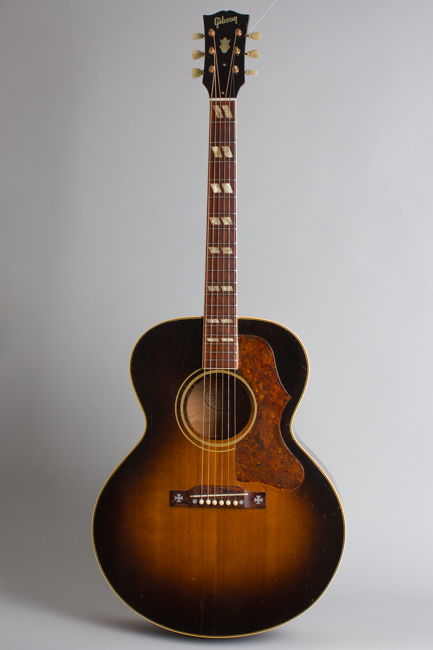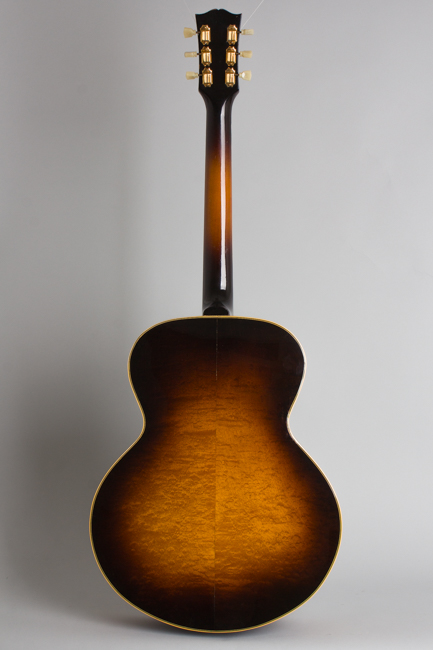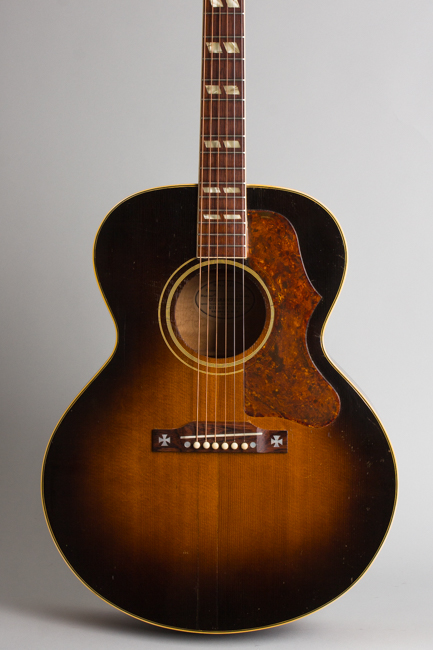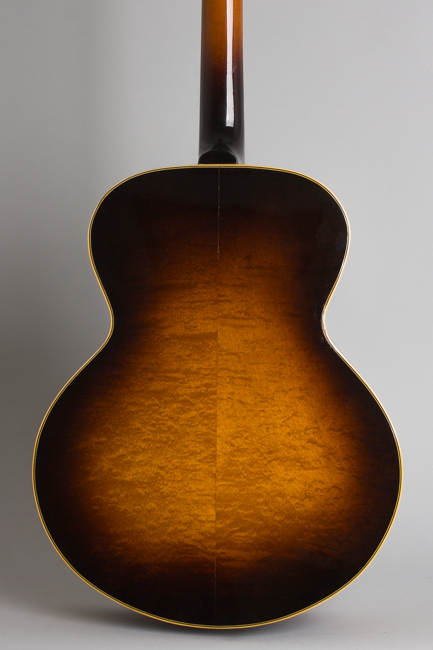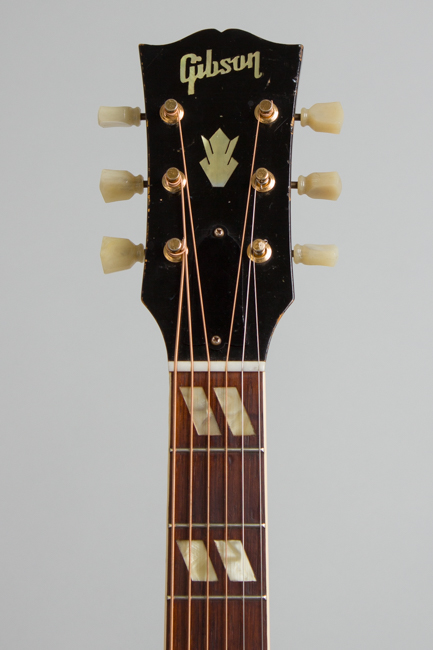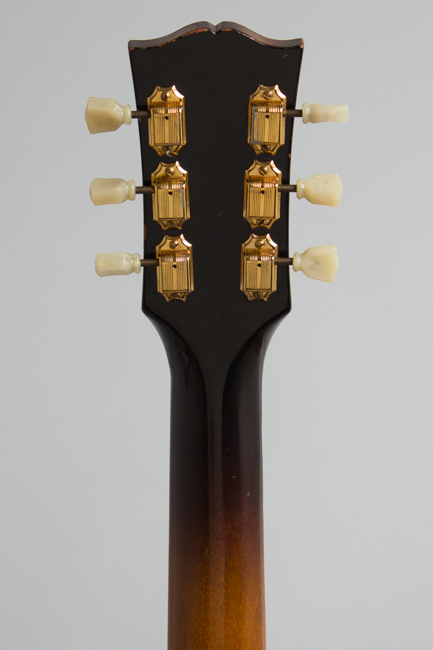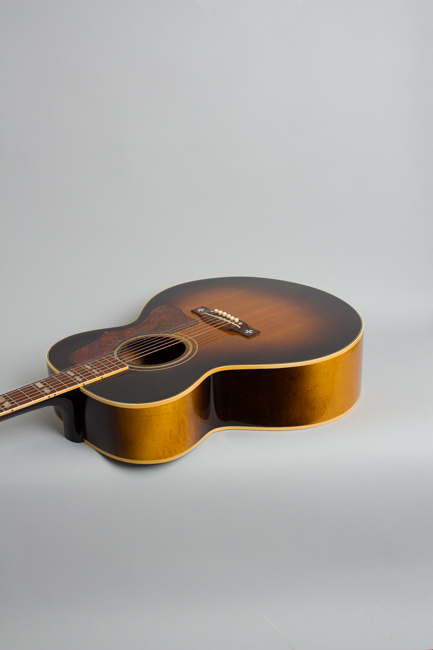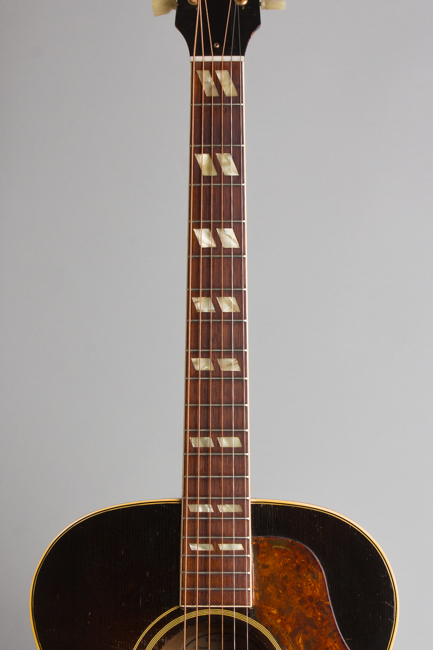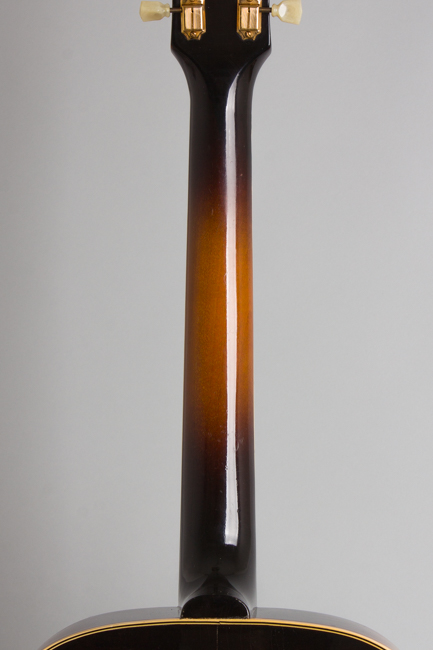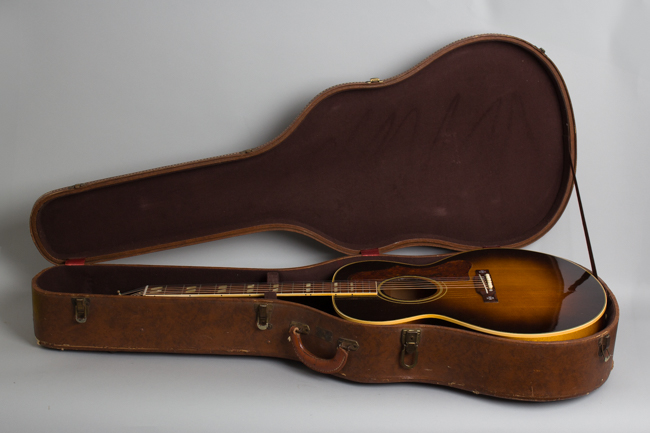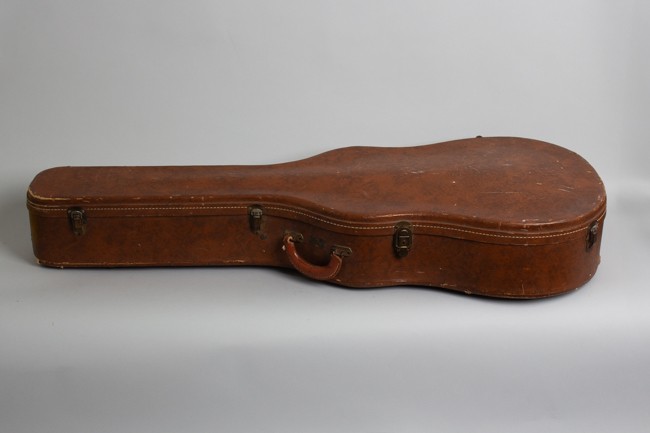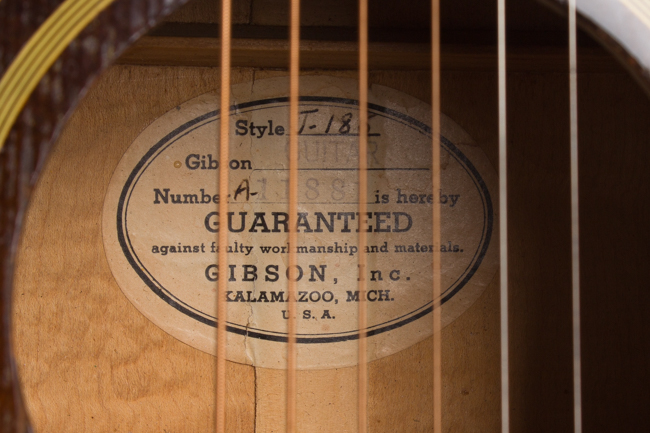Gibson J-185 Flat Top Acoustic Guitar (1952)
This item is currently on hold.
Item # 12703
Prices subject to change without notice.
Gibson J-185 Model Flat Top Acoustic Guitar (1952), made in Kalamazoo, Michigan, serial # A-11881, sunburst lacquer finish, flame maple back and sides, spruce top; mahogany neck with rosewood fingerboard, original brown hard shell case.
This guitar does not shows evidence of a whole lot of play time, but has had some repair work along the way. This includes an old over finish to the back of the neck and a couple of noticeable top cracks. None of this impedes the guitar's function or sound, and it is still a lovely instrument.
The Gibson J-185 has gained a formidable reputation over the decades as one of the absolute finest of Kalamazoo-made flat-tops, and remains a unique design. To some players this is simply one of the best flat tops ever made. In production through the 1950s, this 16" narrow-waisted Jumbo model never established itself properly with players at the time but has garnered a splendid reputation in retrospect.
This guitar has a serial number indicating it was shipped in early November 1952, the second year of production. It is one of only 648 total sunburst J-185's built in the entire decade, 137 of which left Kalamazoo in '52. These numbers are very small for such a well-regarded guitar, but this model suffered from the "Midline Blues". It seems most folks who could afford one went all out and bought a J-200, while the rest stuck with the familiar and more affordable J-45 family. After several more years of slumping sales the J-185 was finally discontinued in 1959.
The J-185 represents Gibson's second attempt to create a less expensive guitar to complement the top-of-the-line "King of the Flat-tops" SJ-200, the first being the virtually dead-on-arrival SJ-100 of 1939-41. This is basically a plainer 16" wide version of the more "yee-haw" 17" J-200. The slightly smaller body retains the same narrow-waisted shape and materials but has lighter construction resulting in a handier, much more responsive guitar. The cosmetics are a bit plainer, but still make for an impressive-looking instrument. This beauty has subtly burled maple back and straight-grained spruce top under a shaded sunburst finish. The top and back are triple-bound and the tortoise celluloid pickguard is the same shape as the J-200 but thinner, and not ornamented with engraving.
The medium/slim round-profile one-piece mahogany neck is topped with a bound rosewood fingerboard sporting Gibson's classic double parallelogram inlay. The unbound headstock has a crown inlay on the face and mounts gold-plated Kluson Deluxe tuners with keystone buttons. A unique feature of the J-185 is pearl Maltese crosses inlaid on the wings of the "belly-up" rosewood bridge, an attractive if eccentric cosmetic touch reserved for this model alone.
Since the 1950s the J-185's sound, feel and relative rarity have made it the most sought-after post-war Gibson flat-top. A few name players had one in the 1960s, notably blues legend Skip James at the end of his career. A different blues connection made them much desired among fingerstyle players: Reverend Gary Davis favored Gibson's J-200 during the 1960s, but the lighter and more responsive J-185 is a preferred instrument among many who follow in the Reverend's style. This is a superbly versatile guitar with a smooth, rich tone for a maple bodied instrument.
Overall length is 41 in. (104.1 cm.), 16 1/16 in. (40.8 cm.) wide at lower bout, and 4 5/8 in. (11.7 cm.) in depth at side, taken at the end block. Scale length is 24 3/4 in. (629 mm.). Width of nut is 1 11/16 in. (43 mm.).
This is a relatively clean if not untouched 70+ year old example of this much-desired instrument, not showing too much wear overall but some older repair work still remaining a fine sounding guitar. The original lacquer finish is intact on the top, back and sides showing light checking and some dings, dents and scrapes but is mostly pretty clean. There is far less pick wear to the top than many, mostly confined to some nicks and dings to the edges of the soundhole.
The neck finish appears to have been oversprayed with nitrocellulose lacquer from head to heel long ago, although we can see no obvious reason why. The neck does not appear to have been reset, and there is no visible evidence of any headstock cracks or damage. One thing we can see is there is an old factory "stinger" on the back of the headstock under this finish, only really visible under UV light. The headstock face has not been overfinished and has some checking and typical edge chipping. The gold Kluson tuners remain original.
There is a long repaired grain split on the top running from the bridge to the back edge behind the low E string pin, and the center seam has also been resealed. Both of these are sealed up with some topical touch up and minor cleating internally. There is also a small cleated grain split on the forward soundhole edge off the treble side of the fingerboard and another along the top edge of the pickguard. Parts of the back center seam have opened slightly and been resealed with some light topical touchup in spots.
The original bridge looks to have been lowered just slightly in front of the saddle long ago. The bone saddle is newer, and fairly low; the action is currently comfortable at 3/32" treble and 4/32" bass but has no room for further lowering. The bridge was likely reglued at some point but internally the small maple bridge plate is original and the bridge retaining bolts are still intact.
The guitar retains the original small-wire frets showing light wear in the lower positions. It plays very well and sounds both crisp and warm, very responsive for a large bodied guitar. It rests happily in the original brown Lifton HSC. Overall Very Good + Condition.
This guitar does not shows evidence of a whole lot of play time, but has had some repair work along the way. This includes an old over finish to the back of the neck and a couple of noticeable top cracks. None of this impedes the guitar's function or sound, and it is still a lovely instrument.
The Gibson J-185 has gained a formidable reputation over the decades as one of the absolute finest of Kalamazoo-made flat-tops, and remains a unique design. To some players this is simply one of the best flat tops ever made. In production through the 1950s, this 16" narrow-waisted Jumbo model never established itself properly with players at the time but has garnered a splendid reputation in retrospect.
This guitar has a serial number indicating it was shipped in early November 1952, the second year of production. It is one of only 648 total sunburst J-185's built in the entire decade, 137 of which left Kalamazoo in '52. These numbers are very small for such a well-regarded guitar, but this model suffered from the "Midline Blues". It seems most folks who could afford one went all out and bought a J-200, while the rest stuck with the familiar and more affordable J-45 family. After several more years of slumping sales the J-185 was finally discontinued in 1959.
The J-185 represents Gibson's second attempt to create a less expensive guitar to complement the top-of-the-line "King of the Flat-tops" SJ-200, the first being the virtually dead-on-arrival SJ-100 of 1939-41. This is basically a plainer 16" wide version of the more "yee-haw" 17" J-200. The slightly smaller body retains the same narrow-waisted shape and materials but has lighter construction resulting in a handier, much more responsive guitar. The cosmetics are a bit plainer, but still make for an impressive-looking instrument. This beauty has subtly burled maple back and straight-grained spruce top under a shaded sunburst finish. The top and back are triple-bound and the tortoise celluloid pickguard is the same shape as the J-200 but thinner, and not ornamented with engraving.
The medium/slim round-profile one-piece mahogany neck is topped with a bound rosewood fingerboard sporting Gibson's classic double parallelogram inlay. The unbound headstock has a crown inlay on the face and mounts gold-plated Kluson Deluxe tuners with keystone buttons. A unique feature of the J-185 is pearl Maltese crosses inlaid on the wings of the "belly-up" rosewood bridge, an attractive if eccentric cosmetic touch reserved for this model alone.
Since the 1950s the J-185's sound, feel and relative rarity have made it the most sought-after post-war Gibson flat-top. A few name players had one in the 1960s, notably blues legend Skip James at the end of his career. A different blues connection made them much desired among fingerstyle players: Reverend Gary Davis favored Gibson's J-200 during the 1960s, but the lighter and more responsive J-185 is a preferred instrument among many who follow in the Reverend's style. This is a superbly versatile guitar with a smooth, rich tone for a maple bodied instrument.
Overall length is 41 in. (104.1 cm.), 16 1/16 in. (40.8 cm.) wide at lower bout, and 4 5/8 in. (11.7 cm.) in depth at side, taken at the end block. Scale length is 24 3/4 in. (629 mm.). Width of nut is 1 11/16 in. (43 mm.).
This is a relatively clean if not untouched 70+ year old example of this much-desired instrument, not showing too much wear overall but some older repair work still remaining a fine sounding guitar. The original lacquer finish is intact on the top, back and sides showing light checking and some dings, dents and scrapes but is mostly pretty clean. There is far less pick wear to the top than many, mostly confined to some nicks and dings to the edges of the soundhole.
The neck finish appears to have been oversprayed with nitrocellulose lacquer from head to heel long ago, although we can see no obvious reason why. The neck does not appear to have been reset, and there is no visible evidence of any headstock cracks or damage. One thing we can see is there is an old factory "stinger" on the back of the headstock under this finish, only really visible under UV light. The headstock face has not been overfinished and has some checking and typical edge chipping. The gold Kluson tuners remain original.
There is a long repaired grain split on the top running from the bridge to the back edge behind the low E string pin, and the center seam has also been resealed. Both of these are sealed up with some topical touch up and minor cleating internally. There is also a small cleated grain split on the forward soundhole edge off the treble side of the fingerboard and another along the top edge of the pickguard. Parts of the back center seam have opened slightly and been resealed with some light topical touchup in spots.
The original bridge looks to have been lowered just slightly in front of the saddle long ago. The bone saddle is newer, and fairly low; the action is currently comfortable at 3/32" treble and 4/32" bass but has no room for further lowering. The bridge was likely reglued at some point but internally the small maple bridge plate is original and the bridge retaining bolts are still intact.
The guitar retains the original small-wire frets showing light wear in the lower positions. It plays very well and sounds both crisp and warm, very responsive for a large bodied guitar. It rests happily in the original brown Lifton HSC. Overall Very Good + Condition.
